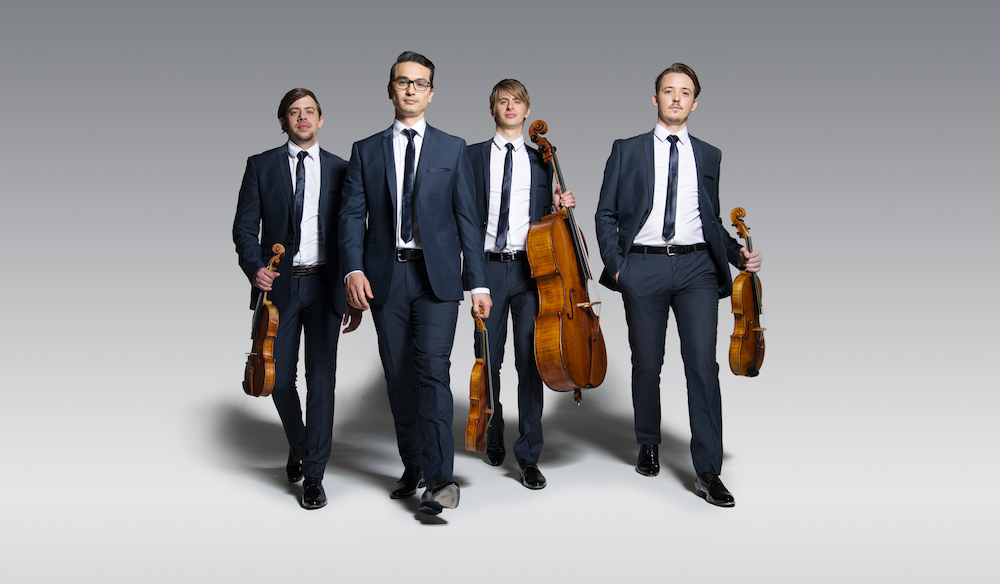Melbourne Recital Centre
October 25, 2018
Sharply-dressed and full of interpretive insight, the Orava Quartet has earned its emerging reputation as one of Australia’s most exciting ensembles. Formed in 2007 by brothers Daniel and Karol Kowalik (violin and cello), and violist Thomas Chawner, later to be joined by violinist David Dalseno, Orava first came to the world’s attention when they won the Musica Viva Tony Berg Award for the most outstanding Australian ensemble at the Asia Pacific Chamber Music Competition in 2013, during which time they were the graduate Quartet-in-Residence at the University of Colorado, studying under the Takács Quartet. They hold residencies at Canada’s Banff Arts Centre and Australia’s Bundanon Trust and have played at most of the major venues and festivals across Australia since their return home. Earlier this year, they became the first Australian ensemble to be selected by Deutsche Grammophon Australia for its first recording release. A Brisbane-based ensemble, Orava are set to be Camerata’s 2019 Artist-in-Residence. It is difficult to see these still relatively young performers slowing down any time soon, and Australian classical music is all the better for it.
 The Orava Quartet: Daniel Kowalik, David Dalseno, Karol Kowalik and Thomas Chawner. Photo © Dylan Evans Photography
The Orava Quartet: Daniel Kowalik, David Dalseno, Karol Kowalik and Thomas Chawner. Photo © Dylan Evans Photography
Thursday night’s concert at the Melbourne Recital Centre – as part of its Southbank Series – deserved a much larger attendance. The theme was Czech: Haydn’s String Quartet in G, ‘Lobkowitz’, belonging to his final group of compositions and commissioned by the Bohemian Prince Joseph Franz von Lobkowitz in 1799, followed by the rarely-heard Five Pieces for String Quartet by Czech composer Erwin Schulhoff, and completed by Debussy’s beloved, singular string quartet, marking the centenary of the composer’s passing.
Framed by cellist Karol Kowalik’s opening remarks that the Haydn string quartets were, by this stage in his career, essentially pop music, Orava began with a polite, accomplished, and neatly-executed interpretation of the String Quartet in G, revealing a distinct rapport and unity between four performers with clearly distinct personalities. The quartet displayed precise melodic balance and precision, and a smattering of tasteful dynamic flair, which made their Debussy finale an especially beautiful, richly atmospheric affair. Their interpretation was expansive, and they seemed to delight in the spaces between notes, as Debussy would have put it – a difficult feat in the sometimes stiflingly dry acoustics of the Elisabeth Murdoch Hall. Where the quartet fully excelled, however, was in the Schulhoff.
Czech composer Erwin Schulhoff was one of the most popular composers of his time. At first his music exhibited the strong influence of Dvořák, Debussy, and Scriabin, four years in the Austrian army during the First World War produced a more radical artistic vision, and Schulhoff became an astute student of Expressionism, the Second Viennese School, and the Dadaism of George Grosz. Part of a generation of Jewish artists lost during the Holocaust, Schulhoff was deported to a Nazi concentration camp in 1941 and died of tuberculosis in 1942. His Five Pieces for String Quartet were written in 1923 and are representative of his generation’s rejection of pre-First World War aesthetics. A series of dance movements dedicated to French composer Darius Milhaud, it is full of stylistic experimentation and manipulation. Ranging from a grotesque opening waltz to a furious concluding tarantella, Schulhoff’s creation was an ideal vehicle for the Orava Quartet to showcase its technical and artistic mastery.
An energetic, kinetic ensemble, there was a clear affinity between the quartet’s corporate personality and the Schulhoff’s musical philosophy. Writing in 1919, Schulhoff said that “Music should first and foremost produce physical pleasure, yes, even ecstasies. Music is never philosophy – it arises from an ecstatic condition, finding its expression through rhythmical movement.” Later, his work would more fully embody the avant-garde artistic movements that emerged out of the First World War; as one philosopher has written, Schulhoff’s generation of composers believed that “the society that could countenance (and give rise to) the advent of something as inhuman as the First World War, was in dire need of destruction, so that it could be re-built in a radically different way”.
Despite excellent treatments of the Haydn and Debussy, it was while performing this more modern repertoire that the Orava Quartet seemed most comfortable, open, and expressive. Much the same could be said for their recording of Shostakovich’s String Quartet No 8 for Deutsche Grammophon – just as thrilling in a live performance – or their encore, a quartet arrangement of Woljchiech Kilar’s motoric, relentless Orawa for Chamber String Orchestra – the source of the group’s name, no less. One can imagine an excellent Bartók cycle somewhere in this quartet’s recording future. While an emerging ensemble needs to be seen to have paid its dues, the Orava Quartet are well past this point, and are well-positioned now to bring some more adventurous repertoire to Australian concert halls.











Comments
Log in to join the conversation.